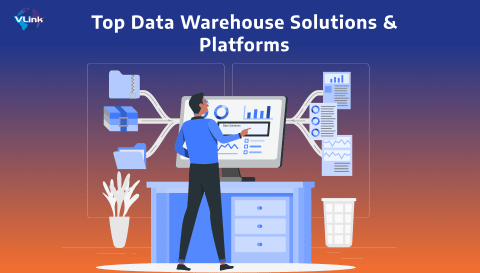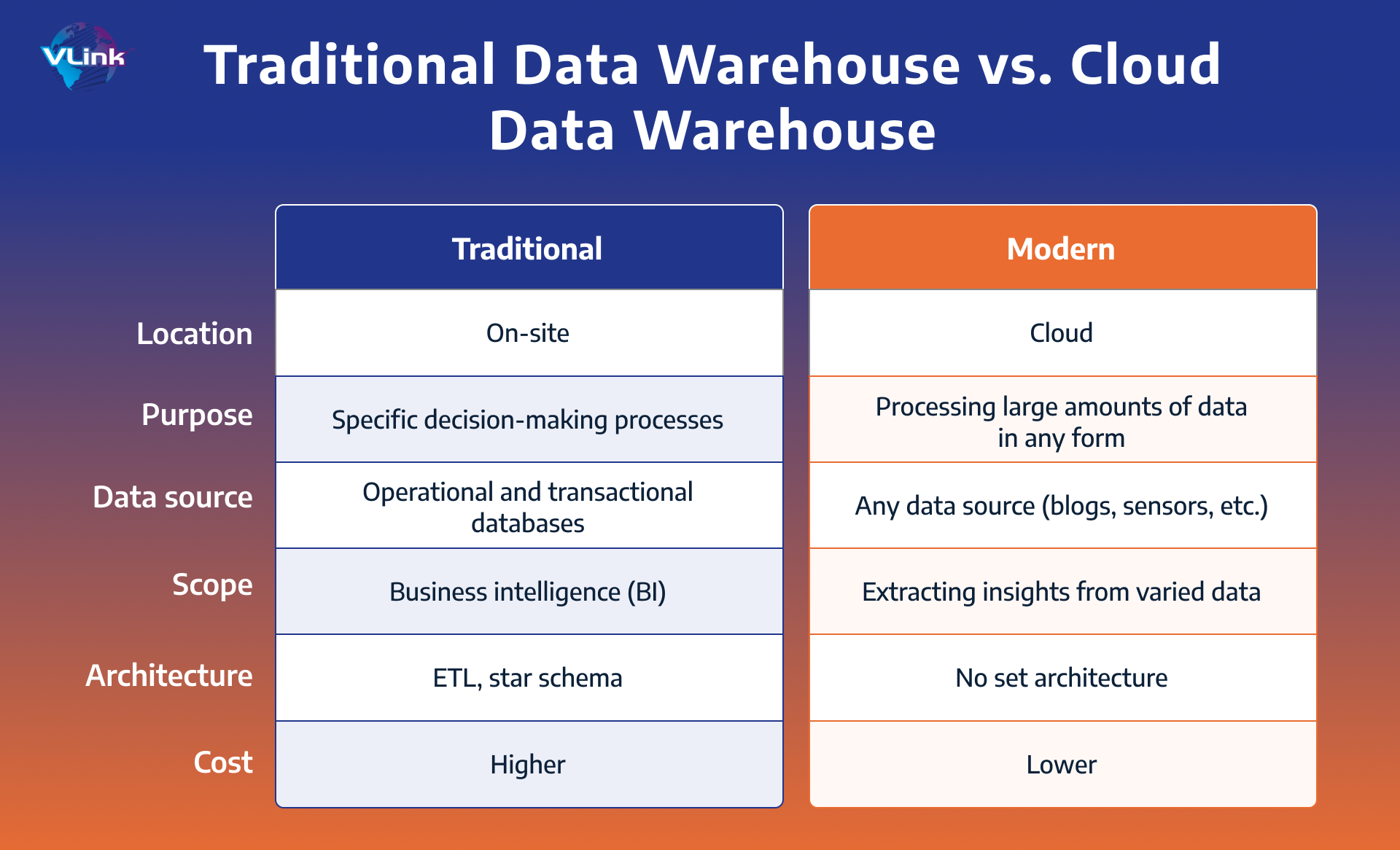Top Data Warehouse Platforms And which is best for your business?
Data analysis has become an integral aspect of enterprises in the era of information. For the past 20 years, businesses have invested in data collecting tools, and as a result, they now have access to enormous volumes of data across several platforms.
 4 minute
4 minute


Data extraction, cleansing, and transformation are made better with the use of data warehouse software and technologies. Additionally, they support data fusion and information updates from data sources. In comparison to traditional systems, contemporary data architecture offers the combined power of a data warehouse, the elasticity of the cloud, and the flexibility of big data platforms at a far lower cost.
The top data warehouse solutions are listed here, along with a detailed summary of each tool's use cases, key features, advantages, and disadvantages. But before starting with them, it is necessary to understand why choose cloud data warehouses!
Why your business needs a cloud data warehouse solution?
The requirement to combine and simplify this varied information arises from the fact that the data warehouse contains data from several sources. For data warehousing systems to function better, repetitive operations must be automated.
You should consider deploying a cloud data warehouse if you want to do any of the following:
- Centrally store all of your business-critical data
- Analyze your web, mobile, CRM, and other applications together in a single place
- Dive deeper than traditional analytics tools by querying raw data with SQL
- Provide multiple people access to the same data set simultaneously
By turning enormous volumes of unstructured data into information that matters, a data warehouse improves business intelligence. One of the numerous advantages of data warehousing is that an organization may use it to forecast both present and future market trends.
A comparison between traditional data warehouse vs cloud data warehouse is given below:

Additionally, you need intelligent analytics to record insights from your data if you want to use it purposefully. In order to effectively pool your data and make better decisions, you need a strong cloud data warehouse solution.
Below are the top data warehouse solutions that businesses can choose from. Let’s get to know about them.
Top 7 Data Warehouse Solutions & Platforms
1- Snowflake
One of the most well-liked data warehousing products available is called Snowflake, and it offers fantastic performance across many public clouds. Companies may do reporting and analytics with Snowflake without incurring large overhead expenses by pulling data from a variety of business intelligence platforms. And because of its fast data processing capabilities, it really is an inexpensive choice for bigger businesses.
Top features:
- JSON, XML, and Avro are just a few of the structured and unstructured data sources that Snowflake can load and optimize data from.
- It offers safeguards for cloud data security, such as continuous data encryption both in transit and at rest.
- Numerous practical features are available, including Time Travel historical data access, Fail-safe data recovery, zero-copy cloning, and others.
Pros | Cons |
Supports multi-cloud infrastructure. | Access control & cost can be challenging. |
Data processing becomes easier. | Not for non-technical users. |
Quick analysis & reporting. | Non-supportive to unstructured data. |
Perfect for large amount of data. | Not for small businesses |
2- Amazon Redshift
A straightforward and reasonably priced data warehouse technology, Amazon Redshift supports effective data analysis at the business level. Millions of customers have come to trust AWS as a world leader in cloud infrastructure and platform services.
Real-time and predictive insights are provided by Amazon Redshift for improved business intelligence. It boasts top features including automatic infrastructure provisioning, swift data processing, and flexible data querying, and thanks to its effective machine-learning capabilities, it can easily handle heavy workloads.
Key features:
- AI-powered Redshift helps to boost predictive analytics in real-time.
- Parallel processing makes the distribution of SQL operations flexible and scalable.
- Availability of multiple functionalities like computations, analytics, time stamping, and access control.
- Workload management (WLM) allows developers to establish priorities for clustered queries.
Pros | Cons |
Delivers high performance & real-time insights. | Steep learning curve for beginners |
Query processing for exabyte of data. | Load capacity management required. |
Easy to scale within minutes. | Slightly expensive for additional integrations. |
3- IBM Db2
Real-time analytics provided by IBM Db2 Warehouse assist enterprises in managing varying analytics workloads. It is a completely managed, elastic, cloud-native data warehouse that facilitates extremely large-scale data processing and sharing.
For big company customers looking for streamlined data warehouse administration and management, IBM is the leading choice. Customers come from a variety of industrial sectors, including banking and finance, healthcare, travel and tourism.
Top features:
- Integrated with cloud automation makes it completely manageable.
- Assured scalability based on resource allotment and additional requirements.
- The load time is reduced to half.
- Standardized security for data analytics at scaled level.
Pros | Cons |
End-to-end encryption & security. | Dashboard is quite fizzy. |
Data sharing is flexible. | Small upgrade required over access control. |
Compatible with on-premises warehouses. | Lack of timely updates. |
4- Google BigQuery
Google is unquestionably the most popular search engine. However, it has also created substantial cloud-based data management solutions and controlled the industry.
A online data warehouse called Google BigQuery enables companies to innovate with data. This enterprise-level application can analyze huge datasets using SQL queries and has built-in machine learning capabilities.
Businesses across a variety of sectors, including retail, financial services, media and entertainment, healthcare and life sciences, and even government organizations, have utilized Google BigQuery on a worldwide scale.
Key Elements
- Data engineers can easily build machine learning models to operate queries.
- Comes with multi-cloud capabilities to handle queries parallelly from different resources.
- Access to DataStream for synchronizing data with different resources like cloud systems, databases, and other applications.
- Integration of NLP (Natural Language Processing) ease of access to real-time data insights.
Pros | Cons |
Flexible to customize & manage. | Complex for non-technical users. |
Ease of query execution on large datasets. | Pricing varies according to the size of data. |
Automated data segregation & storage. | Bit complicated to setup. |
5- Azure Synapse
Currently, Microsoft Azure provides more than 200 goods and services. Different data storage, big data systems, data analytics, and business intelligence solutions are available that assist in removing data barriers and provide insightful data.
Enterprise warehousing and big data analytics have been combined in Azure Synapse Analytics to provide infinite analytics capabilities. With petabyte-scale analytics and multi-layered security, it provides immense value.
Azure Data Warehouse solutions are used by both small and big firms in the financial services, industrial, retail, and healthcare sectors.
Key Features:
- Intelligent handling of the workload.
- One environment for machine learning and analytics activities.
- High-performance SQL and Apache Spark engines for better cooperation.
- Analytical query engine for telemetry and logs.
Pros | Cons |
Easy monitoring of complex pipelines. | Not supportive of serverless architecture |
Availability of diverse DW tools. | Pricing is complex to choose. |
AI-integration makes it more efficient. | Requires technical expertise. |
Also Read: A Comprehensive Guide To Data Warehouse Design & Development
6- Databricks
An open, multi-cloud platform called Databricks combines the finest features of data lakes and data warehouses into a single, cohesive design. For your team, which may include data analysts, data engineers, data scientists, and business analysts, it offers integrated data analytics tools.
Your one-stop shop for all your data needs is Databricks. For instance, it can create connections to visualization tools like Power BI, Tableau, and QlikView, as well as predictive models using Spark ML and insights using Spark SQL.
Top features:
- Supports a variety of programming languages on a single platform, including Python for evaluating the performance of models and Spark SQL for data processing tasks.
- Enables the processing of both small- and large-scale projects with ease by offering highly scalable Spark jobs.
- Connect to CSV, JSON, and on-premises SQL services among other data sources.
Pros | Cons |
Easy to manage pipelines. | Need proficient programmers to handle. |
Combined languages – Python, SQL & R. | Structured around single model. |
Vast community due to open source | Lesser speed compared to other platforms. |
7- Firebolt
Firebolt, a favorite of both data engineers and data analysts, is another significant participant in data warehousing. Its focus is speed, and what separates them from the competitors is their order-of-magnitude performance.
Firebolt, which was designed for current use, can handle semi-structured data, or datasets that fall between totally structured and unstructured. With its decoupled storage and computing architecture, Firebolt claims to have been designed for data lake size volumes.
- Handles semi-structured data using native lambda expressions.
- Supports multi-master continuous ingestion, single-row inserts, and automated rebalances.
- Separates data storage from processors for smooth execution of computer-intensive operations like ETL or ELT processes.
- Makes use of optimized aggregate, sparse data, and join indexes for better query performance.
Pros | Cons |
Serverless & elastic infrastructure | Manual interventions required. |
Flexible for semi-structured datasets | Includes other overhead costs. |
Highly customization & pay-as-you-go model. | Speedy but entails quirks in between. |
How to choose the right data warehouse solution for your business?
It's not simple to choose the best data warehouse for your company. There are several alternatives available, and each has a unique set of qualities to consider.
To top it all off, constructing a data warehouse without a technology like Segment may be exceedingly challenging and time-consuming. So you wouldn't want to alter your opinion about it after it was put into practice.
When choosing a data warehouse for your team's needs after determining that one is required, keep the following points in mind:
- Data types: Identifying the type of data to be stored in your warehouse.
- Size: total amount of datasets you require to store in the chosen data warehouse.
- Performance: desired speed of the query processing on the data
- Maintenance: required efforts to manage and control data warehousing processes.
- Cost: budget in which you are seeking to invest in data warehouse deployment.
- Community: required tools and resources for integration after the deployment of your data warehouse.
Consider a data warehouse as the place where all your data is stored. Companies combine data from several sources into a data warehouse to make it simple to analyze.
VLink’s recommendation & offerings
Check out the online support community for the tool you're considering to see what type of assistance is available.
Our top suggestions are listed below:
- Snowflake is the best choice if you want your data team to work together smoothly while utilizing a contemporary, simple, and quick cloud data warehousing solution.
- Choose Google BigQuery or Amazon Redshift if you want a solution that interacts easily with your current cloud platform.
Choosing a potent cloud data warehousing platform might be a wonderful place to start for most teams that are faced with "doing more with less".
VLink is something you should give serious consideration if you're thinking about creating a data warehouse. We simply focus on scalable functions and simplicity with getting started. You may quickly launch the initial version of your data warehouse thanks to Panoply's extensive built-in interfaces with several well-known web platforms.





